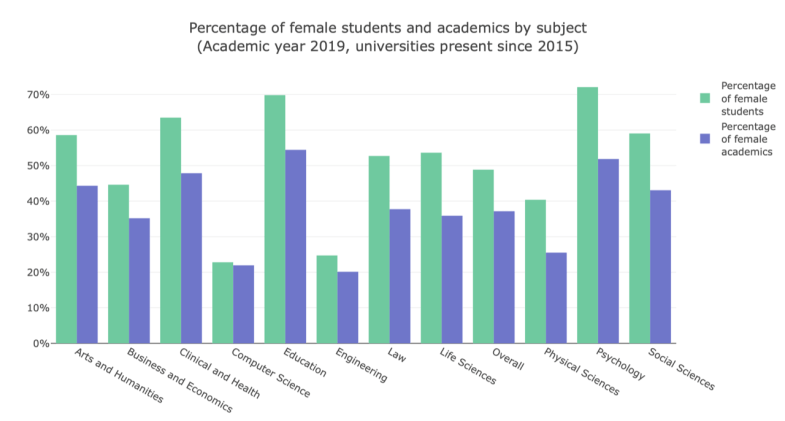What is the state of play when it comes to access to higher education and a career in academia for women? When looking at the numbers of university students and faculty by gender on a global scale, the figures look positive – but dig a little deeper and inequities emerge.
Data from Times Higher Education’s World University Rankings 2022, submitted by 1,662 universities from 99 territories, reveal the regions and subjects in which women continue to face barriers to progression.
Across the world, nearly half (49 per cent) of all university students are female, but the proportion of faculty is just over a third (37 per cent), based on 2019 figures, exposing a drop-off between higher education and a career in academia.
Disappointingly, these proportions have not changed significantly over the past five years. In 2015, women made up 48 per cent of students and 35 per cent of faculty.
These proportions vary somewhat by continent. When looking at the share of female students by region, all regions but one have above 50 per cent: Oceania has the highest proportion, 55 per cent, followed by Africa (53 per cent), Europe (52 per cent), North America (51 per cent) and South America (50 per cent). Asia brings the global average down, with 45 per cent female students. (The regional averages are calculated based on all institutions in the region, rather than country averages).
When it comes to faculty, Asia also has the lowest proportion of women, just 32 per cent, followed by North America (41 per cent) and Europe, South America and Africa (all tied at 42 per cent). Although it has the highest proportion of female faculty at 46 per cent, Oceania saw a slight drop of 0.2 percentage point between 2018 and 2019. It was the only region to record a fall.
Broken down by subject, the ratios of male to female students and faculty vary considerably. Engineering, for example, has a very low proportion of female students and faculty, 25 per cent and 20 per cent, respectively. Computer science follows a similar pattern, with 23 per cent female students and 22 per cent female academics.
On the other hand, arts and humanities, clinical and health, education, psychology and social sciences all have more than 50 per cent female students across all continents. The highest proportion of women studying is among psychology students in Europe – 75 per cent.
Several subjects have fairly close to 50 per cent representation among students, but a much smaller proportion of female academics. For example, 40 per cent of physical science students are female, compared with 25 per cent of faculty. Similarly, 45 per cent of business and economics students are female but only 35 per cent of faculty.

The biggest increase in the percentage of female staff was in psychology in North America (up from 43 per cent in 2015 to 49 per cent in 2019) and in clinical and health subjects in South America (49 per cent to 54 per cent).
Subjects that come within 10 percentage points of 50 per cent female academics all have significantly more than 50 per cent female students. For example, 48 per cent of clinical and health faculty are female, compared with 63 per cent of the students; 43 per cent of social sciences faculty are female, compared with 59 per cent of students. This may suggest that achieving gender parity among faculty currently requires an over-representation of female students.
There are also some surprising variations by subject within regions. For example, in Africa and South America, 30 per cent and 31 per cent of engineering students, respectively, are female, while in Oceania the figure is just 19.4 per cent. Africa has the highest proportion of female computer science faculty, 37 per cent, while Europe has the lowest, 21 per cent.
rosa.ellis@timeshighereducation.com
A Times Higher Education report on how global universities are performing on gender equality, based on data collected for the THE Impact Rankings, will be published and launched at a webinar on International Women’s Day on 8 March. Register to attend.
Register to continue
Why register?
- Registration is free and only takes a moment
- Once registered, you can read 3 articles a month
- Sign up for our newsletter
Subscribe
Or subscribe for unlimited access to:
- Unlimited access to news, views, insights & reviews
- Digital editions
- Digital access to THE’s university and college rankings analysis
Already registered or a current subscriber? Login








